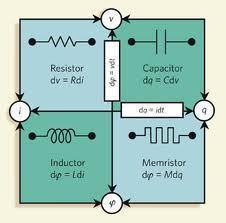Memristor
A memristor is a name given to any sort of two-terminal circuit elements that are both passive and sustain the important relationship between voltage and current and the time integrals of both. In other words, a memristor is used because of a phenomenon known as memristance. To understand what a memristor is, one must first appreciate what memristance is. This leads to the question:
What is Memristance?
Memristance is, as the name suggests, the memory resistance. If a charge flows in one direction, the resistance found within that circuit is bound to increase. If the charge flows in the opposite direction, the resistance found within that circuit is bound to decrease. Memristance comes into play because when the charge stops flowing, the memristor will remember what the resistance was before the flow had been turned off. Therefore, when the flow is turned back on, the resistance will be what it had been when it was turned off and therefore, the memristor will be able to react to the sudden flow of charge.
Because electronic pieces are getting smaller, it is becoming more important to develop memristors to ensure that the device doesn’t get overcharged. Therefore, it is important to take into consideration the memristance of a circuit model so that, when it goes into production, it is made effectively and properly to ensure that the resistance is properly accounted for.
Memristor
As mentioned above, a memristor is a passive device that reacts to the memristance property. It can be compared to a pipe that carries water. Imagine a pipe that was able to expand and contract based on how much water was flowing through. If a lot of water went through the pipe at one time, the pipe would expand to allow it to flow smoothly. If very little was going through, the pipe could contract to allow it to flow smoothly.
This can be compared to a memristor. When the flow of charge is high, the memristor is able to ‘expand.’ When the flow of charge is in the opposite direction, the memristor ‘contracts.’ When the charge disappears, the memristor stays at the size it was when charge last flowed through. Therefore, when the charge turns back on, the memristor can react accordingly.
As memristors become even more well known, there are an increased type of applications it will be used for. According to HP labs, the first application will be in non-volatile random access memory. The second application will be in artificial synapse for neural computing.


Comments - No Responses to “Memristor”
Sorry but comments are closed at this time.